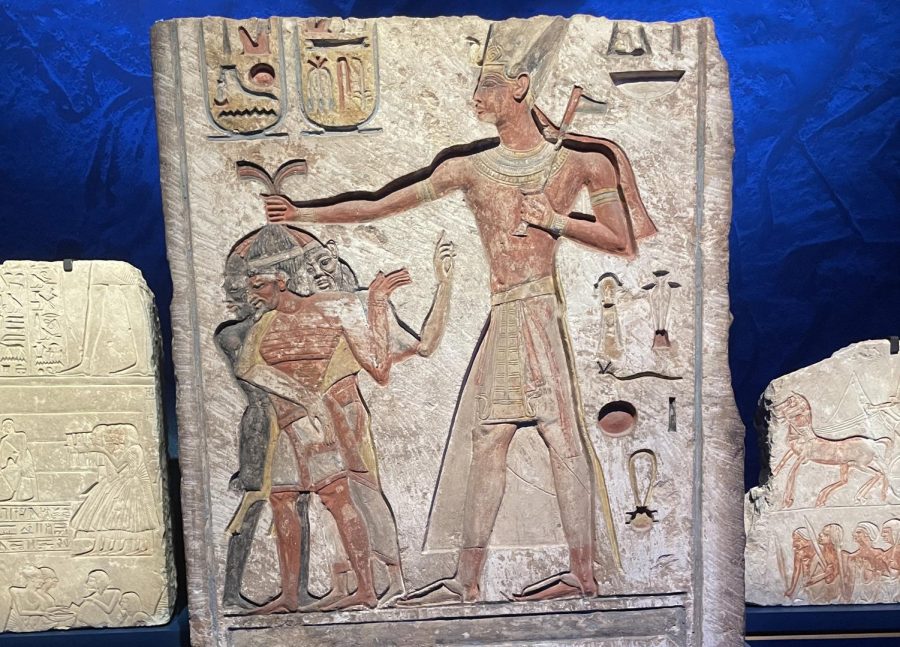Newly excavated Egyptian artifacts made their debut at the “Ramses the Great and the Gold of the Pharaohs” exhibit at San Francisco’s de Young Museum.
“Ramses the Great and the Gold of the Pharaohs” takes a deeper dive into what made ancient Egypt one of the most successful civilizations in history through enhanced multimedia installations and carefully preserved relics, according to the de Young Museum website.
The exhibit features 181 artifacts, including mummies, jewelry, art, statues, and sarcophagi, that focus on the life of Egyptian military officer and long-reigning king Ramses II, or, as he has been known throughout time, Ramses the Great.
“As a longest ruling pharaoh, looking at the artwork of Ramses the Great really speaks to Egyptian empires and the way that they held their government stable for thousands of years,” said Emily Jennings, Director of School and Family Programs at the de Young Museum. “When you think about his accomplishments, I think people get really enticed and curious about his story.”
Ramses the Great is considered to be one of the greatest kings to rule Egypt, according to the de Young Museum website. The numerous artifacts shown in the museum from his long reign, several of them being newly discovered, demonstrate the sheer power of ancient Egypt under such a pharaoh.
He ruled as the third king of the 19th dynasty, and his 67-year reign was the second-longest in Egyptian history, according to Britannica. Ramses the Great, believed to be a living god by ancient Egyptians, is most known for expanding Egypt’s empire while commissioning enormous temples, obelisks, and statues, and establishing the first-ever known peace treaty in history with the Hittites.
Ramses’ military prowess can be seen in the multimedia feature of the Battle of Kadesh at the exhibit, where the viewer can feel immersed in Ramses’ experience of the battle as if they were there, witnessing it take place. Numerous artifacts and artwork along the walls also contribute to the detailed account of the battle.
“Ramses the Great and the Gold of the Pharaohs” is on an international tour that will be featured in museums all over the world. The tour started in Houston in 2021, it’s currently on display in San Francisco, and will continue its journey to Boston, London, Paris, and Sydney, traveling for several years before returning home to Egyptian museums.
For the Egyptian government, one of the main goals of displaying this exhibit all over the world is to raise awareness of the heritage that Egyptian culture holds, according to Jennings, and for the de Young Museum, one of the main goals was providing learning opportunities to the Bay Area community.
The de Young Museum structured the exhibit around different themes to inspire curiosity in students, according to Jennings. The artifacts were placed accordingly.
“I was really intrigued by the artwork … there were also mummified animals and I thought that was really cool,” said Umada Mele, a Carlmont sophomore who visited the exhibit.
According to Jennings, the intrigue shown by students is to be expected due to the meticulous thought put into making the exhibit enjoyable and thought-provoking.
“I think learning about Egypt in a classroom from a textbook is a very standard way of learning. In our case, when you’re looking at an exhibition, it’s a place where you’re really looking at a story that’s been crafted for you to experience. And in that, I think it’s easier to pick up themes,” Jennings said.
Carlmont Ethnic Studies teacher Eric Perkins has also noted that visiting historical museum exhibits allows history to be more interactive, which creates a more lasting impression on students.
Jeffery Tanguay, a World History and Life Skills/Ethnic Studies teacher at Carlmont, shared a similar point of view with Perkins.
“It’s nice to be able to see these things in person. It gives you a different perspective, and the docents are very knowledgeable,” Tanguay said.
The Ramses exhibition is designed to leave students asking themselves questions and understanding the concepts of Egyptian history through multiple different lenses, according to Jennings.
“The exhibit changed my perspective on ancient Egypt. It was kind of explaining new ideas and opening my mind to new concepts. Now I kind of have a better idea about how the ancient Egyptians lived,” said Anyada Mele, a Carlmont sophomore who accompanied her sister, Umada Mele, to the exhibit.
Jennings wanted to leave students with the takeaway that “Ramses the Great and the Gold of the Pharaohs” is deeper than just learning Egyptian history through the life of Ramses the Great.
Jennings said, “There’s a way to feel a sense of connection from human experience across time and space. Exploring what was in an individual’s successes, what were their struggles, and feeling that sense of humanity.”
























